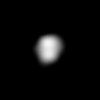 Belinda viewed by Voyager 2 in 1986 | |
| Discovery | |
|---|---|
| Discovered by | Stephen P. Synnott / Voyager 2 |
| Discovery date | January 13, 1986 |
| Designations | |
Designation | Uranus XIV |
| Pronunciation | /bəˈlɪndə/[1] |
| Adjectives | Belindian |
| Orbital characteristics[2] | |
| 75 255.613 ± 0.057 km | |
| Eccentricity | 0.00007 ± 0.000073 |
| 0.623527470 ± 0.000000017 d | |
| Inclination | 0.03063 ± 0.028° (to Uranus' equator) |
| Satellite of | Uranus |
| Physical characteristics | |
| Dimensions | 128 × 64 × 64 km[3][note 1] |
| ~22000 km2[a] | |
| Volume | ~270000 km3[b] |
| Mass | ~(1.4–2.3)×1017 kg[a][c] |
Mean density | 0.5–0.84 g/cm3[8][d] |
| ~0.002–0.015 m/s2[e] | |
| ~0.017–0.031 km/s[f] | |
| synchronous[3] | |
| zero[3] | |
| Albedo | 0.08 ± 0.01[9] |
| Temperature | ~64 K[a] |
| |
Belinda is an inner satellite of the planet Uranus. Belinda was discovered from the images taken by Voyager 2 on 13 January 1986 and was given the temporary designation S/1986 U 5.[10] It is named after the heroine of Alexander Pope's The Rape of the Lock. It is also designated Uranus XIV.[11]
Belinda belongs to the Portia group of satellites, which also includes Bianca, Cressida, Desdemona, Portia, Juliet, Cupid, Rosalind, and Perdita.[9] These satellites have similar orbits and photometric properties.[9] Other than its orbit,[2] size of 128 × 64 km,[3] and geometric albedo of 0.08,[9] virtually nothing is known about it.
Voyager 2 images show Belinda as an elongated object with its major axis pointing towards Uranus. The moon is very elongated, with its short axis 0.5 ± 0.1 times the long axis.[3] Its surface is grey in color.[3]
Belinda is in a stable 44:43 mean-motion resonance with Perdita, and from this its mass has been determined to be roughly 26 times that of Perdita.[4]
The inner moon system is unstable over timescales of several millions of years. Belinda and Cupid will probably be the first pair of moons to collide, in 100,000 to 10 million years' time depending on the densities of the Portia-group satellites, due to resonant interactions with the much smaller Cupid.[8]
- ^ Benjamin Smith (1903). The Century Dictionary and Cyclopedia.
- ^ a b Jacobson 1998.
- ^ a b c d e f Karkoschka, Voyager 2001.
- ^ a b French, Robert S.; Showalter, Mark R.; de Pater, Imke; Lissauer, Jack J. (2017-10-01). Orbital and Photometric Analysis of the Inner Uranian Satellites from Hubble Images. Vol. 49. p. 214.19.
- ^ Showalter & Lissauer 2006.
- ^ a b Ćuk et al. 2022.
- ^ Showalter & Lissauer (2006),[5] as cited in Ćuk et al. (2022).[6]
- ^ a b French, Robert S.; Showalter, Mark R. (August 2012). "Cupid is doomed: An analysis of the stability of the inner uranian satellites". Icarus. 220 (2): 911–921. arXiv:1408.2543. Bibcode:2012Icar..220..911F. doi:10.1016/j.icarus.2012.06.031. S2CID 9708287.
- ^ a b c d Karkoschka, Hubble 2001.
- ^ IAUC 4164.
- ^ USGS: Planet and Satellite Names and Discoverers.
Cite error: There are <ref group=lower-alpha> tags or {{efn}} templates on this page, but the references will not show without a {{reflist|group=lower-alpha}} template or {{notelist}} template (see the help page).